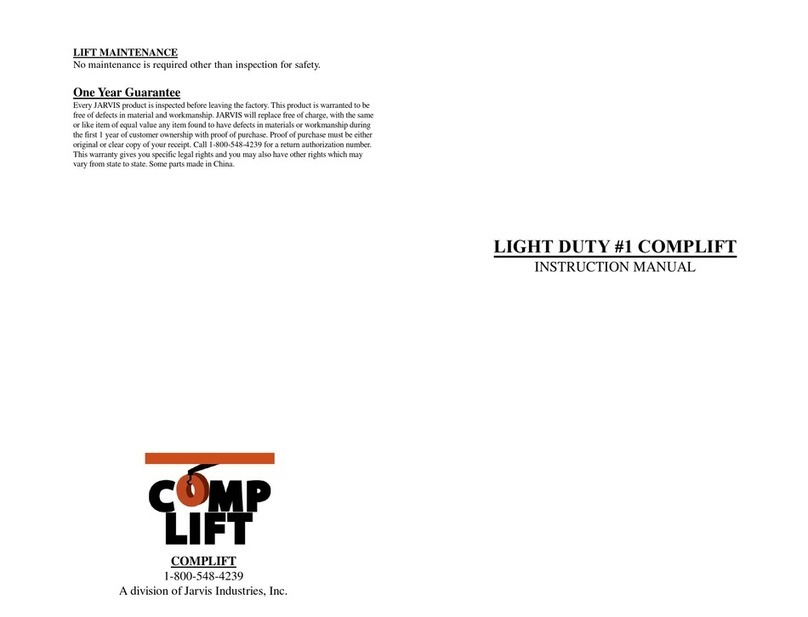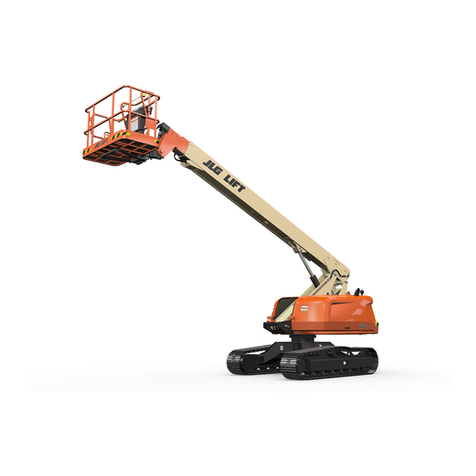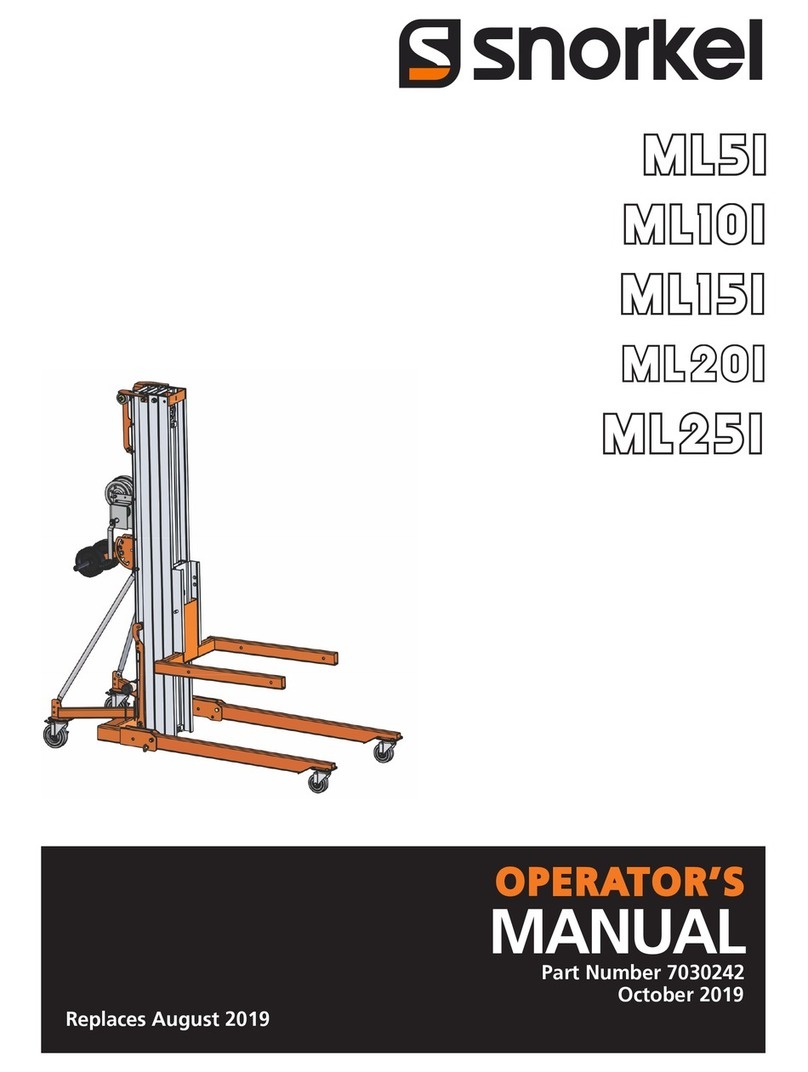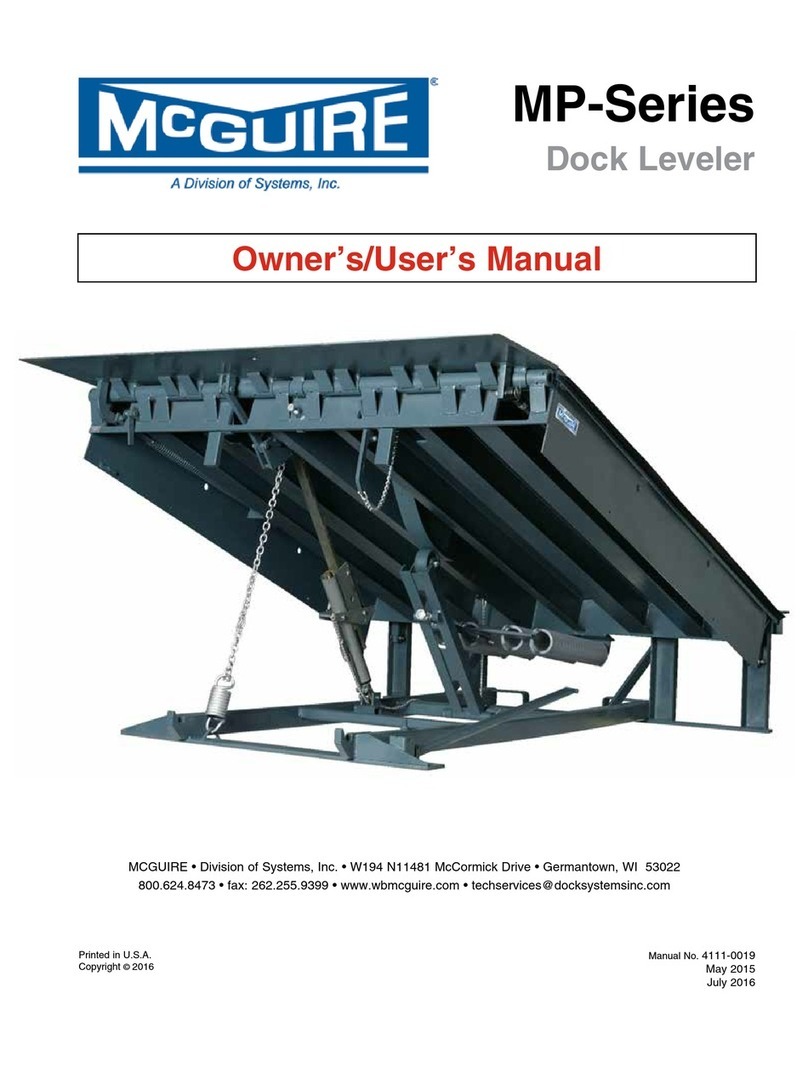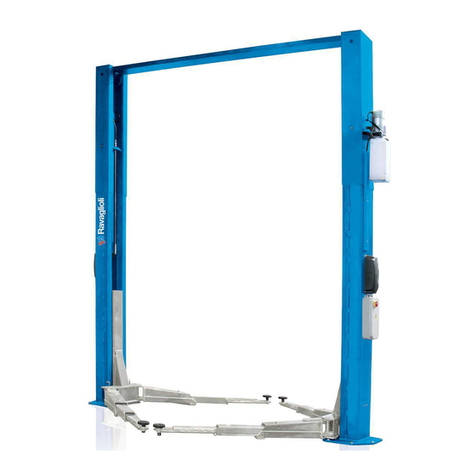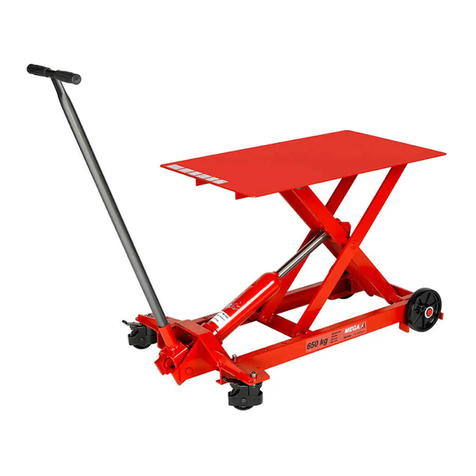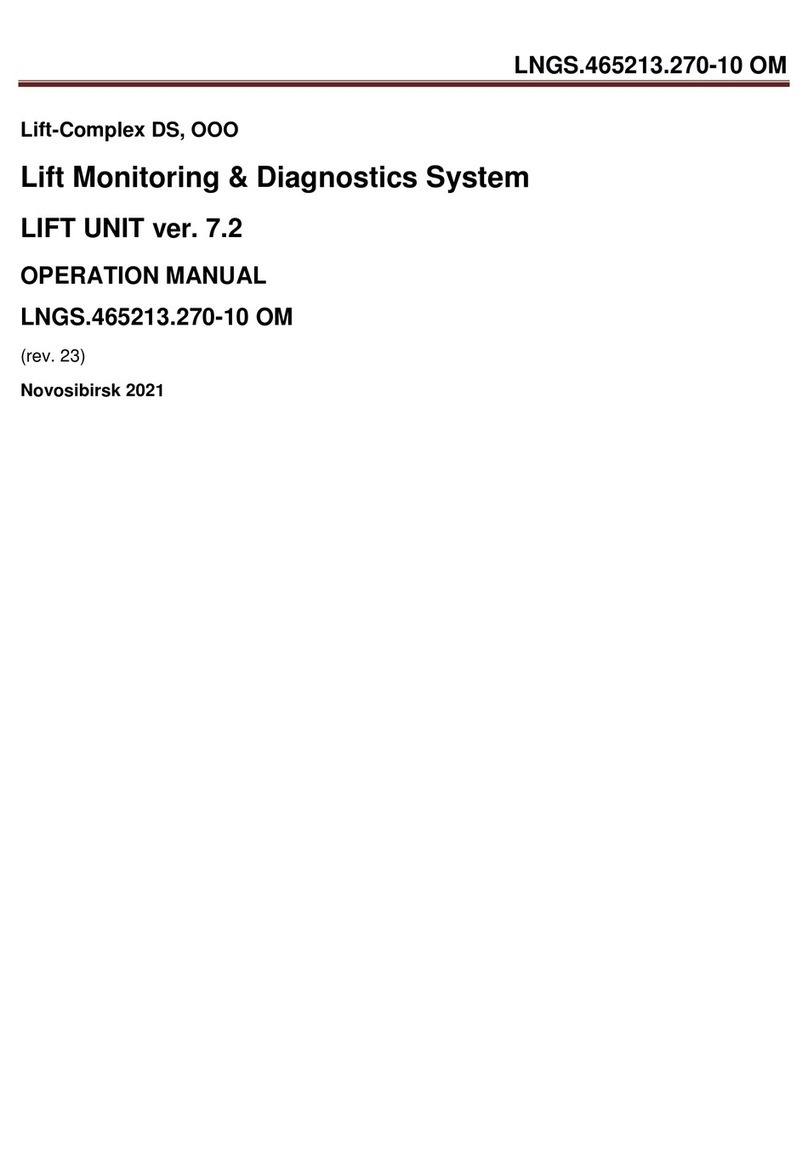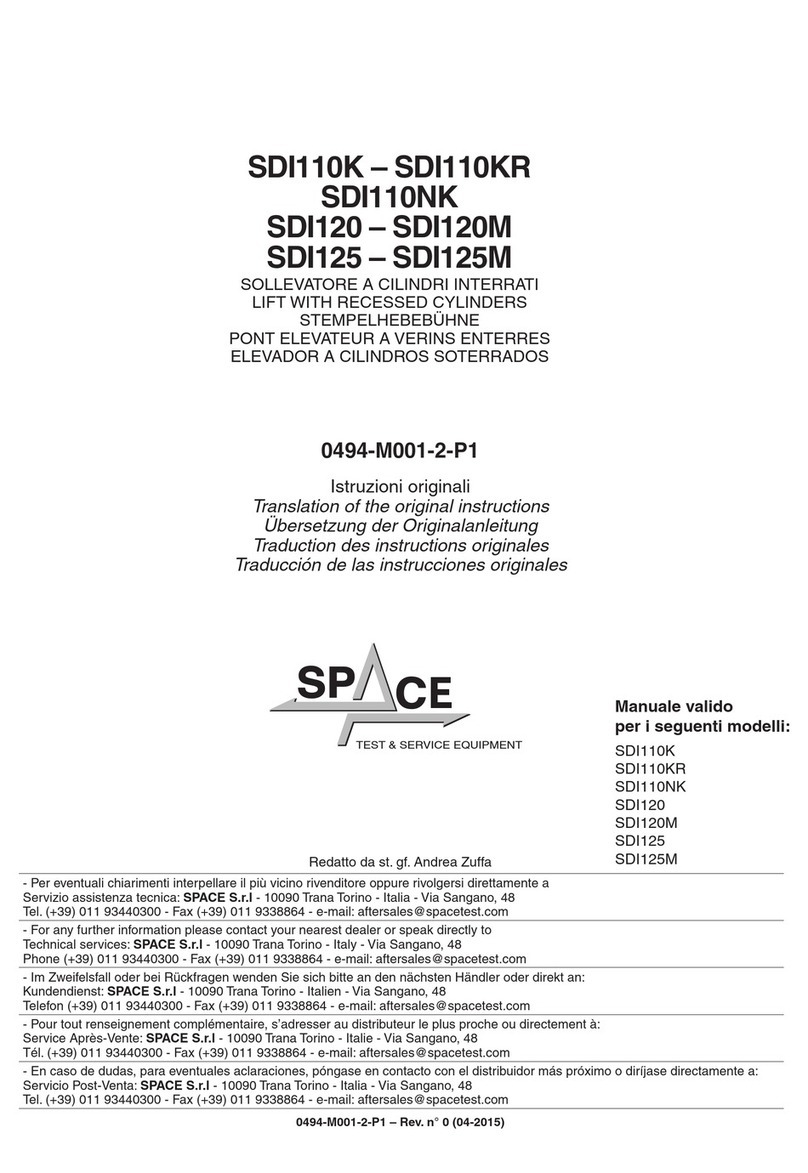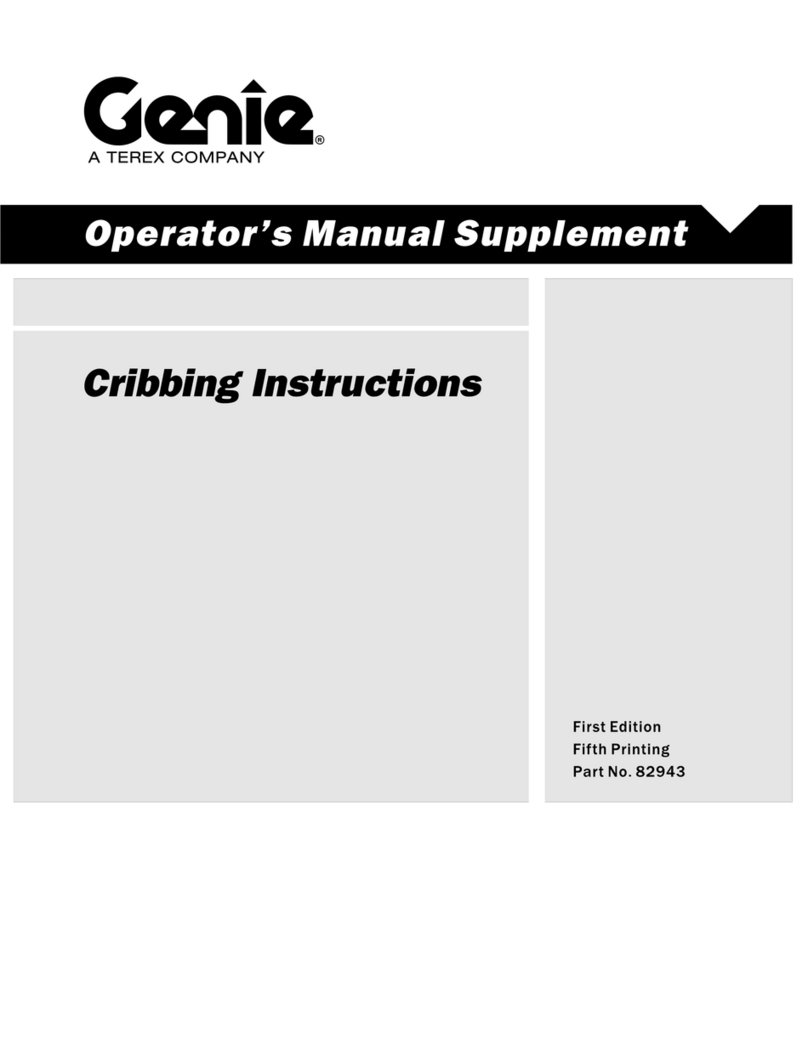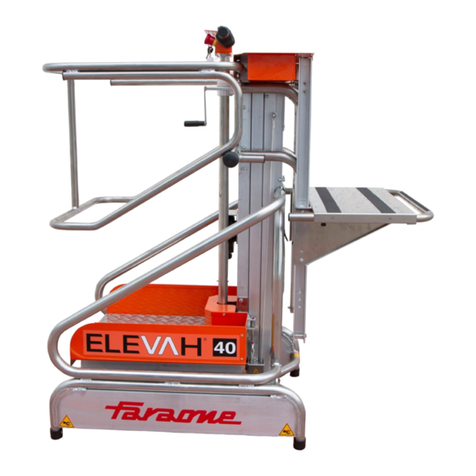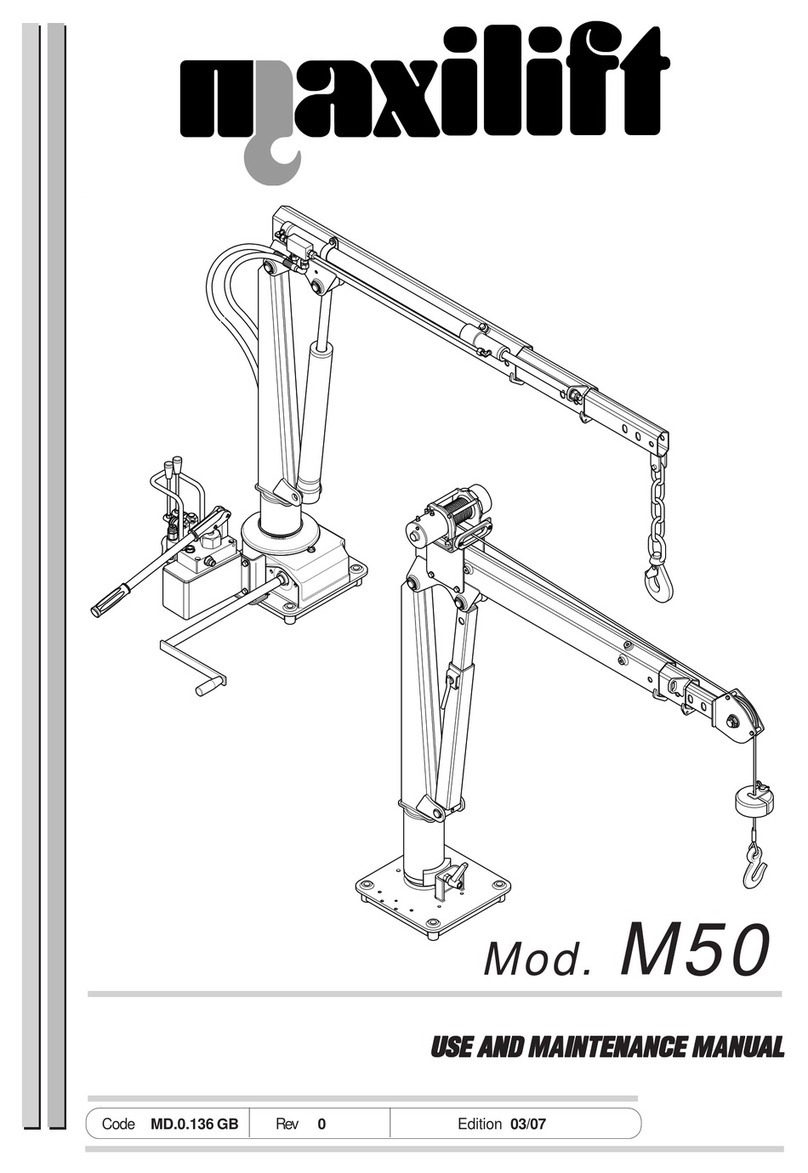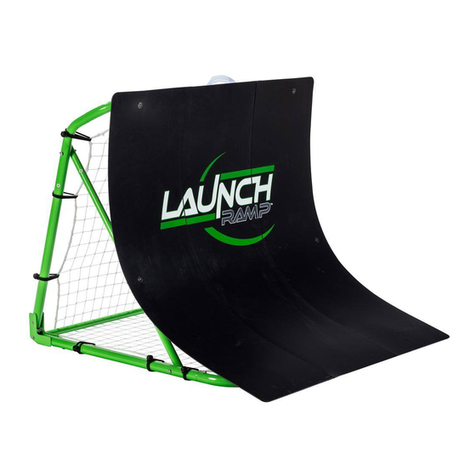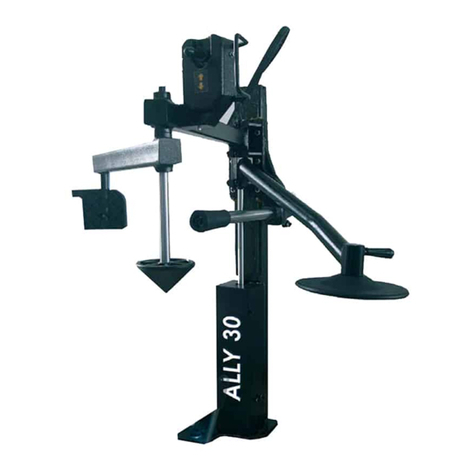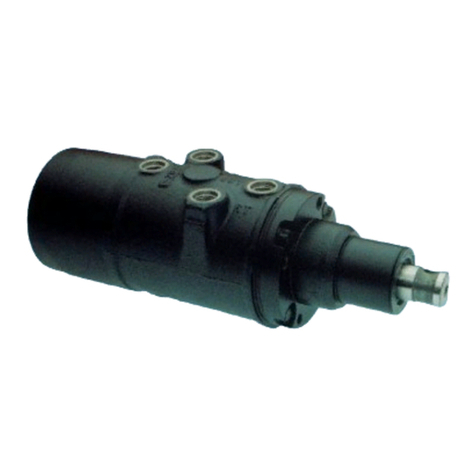Simpro Microstacker User manual

User Manual // Simpro Microstacker
Original Instructions // English // v2.0 // August 2022
USER MANUAL

Copyright © 2022 Simpro Handling Equipment Ltd.
No part of this document may be reproduced or transmitted in any form or by any means,
electronic, mechanical, photocopying, recording, or otherwise, without the written
permission of Simpro Handling Equipment Ltd.
For the purposes of standards compliance and international conformity, this document uses
Système International (SI) units. These may be converted to Imperial units as follows:
1 kilogram (kg) = 2.2 pounds (lb)
1 metre (m) = 1000 millimetres (mm) = 39.37 inches (in) = 3.28 feet (ft) = 1.09 yards (yd)
The following stylistic conventions are used throughout this document:
Point of interest
Safety hazard
§Internal cross-reference (hyperlink in PDF edition)
Simpro Partcode (hyperlink in PDF edition)
Errors in this document should be reported to info@simpro.world

User Manual // Simpro Microstacker
Original Instructions // English // v2.0 // August 2022 // Page 2
A
2339
1033
2581
461
1521
878
MS1400 Default Layout

Con tents
1. Product Overview........................................................................................................ 5
1.1 Key features........................................................................................................................... 5
1.2 Construction .......................................................................................................................... 5
1.3 Mechanism ............................................................................................................................ 5
1.4 Safe Working Load................................................................................................................6
1.5 Duty cycle.............................................................................................................................. 6
1.6 Service life.............................................................................................................................. 6
1.7 Noise emissions ...................................................................................................................... 6
1.8 Environmental restrictions .................................................................................................... 7
1.9 Ingress protection ................................................................................................................. 7
1.10 Notes ...................................................................................................................................... 7
2. Operating Instructions ................................................................................................. 9
2.1 Identification of controls ...................................................................................................... 9
2.1.1 EMERGENCY STOP........................................................................................................................... 9
2.1.2 KEY SWITCH ...................................................................................................................................... 9
2.1.3 BATTERY INDICATOR and HOUR METER (if fitted).......................................................................... 9
2.1.4 RAISE/LOWER rocker switches...................................................................................................... 10
2.1.5 BATTERY SAVER button.................................................................................................................. 10
2.1.6 SAFETY SOUNDER button .............................................................................................................. 10
2.1.7 PARK BRAKE ................................................................................................................................... 10
2.2 Basic operation ................................................................................................................... 11
2.2.1 Turning on the power.................................................................................................................... 11
2.2.2 Moving and steering..................................................................................................................... 11
2.2.3 Lifting and moving bins ................................................................................................................ 11
2.3 Safety Norms........................................................................................................................ 13
3. Handling, Transport & Storage.................................................................................. 15
3.1 Assembly .............................................................................................................................. 15
3.2 Moving ................................................................................................................................. 15
3.3 Lifting .................................................................................................................................... 15
3.4 Transportation......................................................................................................................15
3.5 Storage................................................................................................................................. 16
4. Care and Maintenance............................................................................................ 17
4.1 Quick Troubleshooting Guide............................................................................................ 17
4.2 Cleaning .............................................................................................................................. 17

User Manual // Simpro Microstacker
Original Instructions // English // v2.0 // August 2022 // Page 4
4.3 Carriage jams......................................................................................................................18
4.3.1 Bin carriage jams while raising..................................................................................................... 18
4.3.2 Carriage jams while lowering ...................................................................................................... 18
4.4 Electrical System ................................................................................................................. 19
4.4.1 AGM battery.................................................................................................................................. 19
4.4.2 LFP battery ..................................................................................................................................... 20
4.4.3 Emergency Stop............................................................................................................................ 21
4.4.4 Circuit breaker............................................................................................................................... 21
4.5 Hydraulic System ................................................................................................................. 22
4.5.1 Powerpack .................................................................................................................................... 22
4.5.2 Control valves................................................................................................................................ 22
4.5.3 Lift Ram .......................................................................................................................................... 22
4.5.4 Open Ram ..................................................................................................................................... 22
4.5.5 Hydraulic fluid................................................................................................................................ 22
4.5.6 Maintenance................................................................................................................................. 23
4.6 Preventative Maintenance Inspections ........................................................................... 23
4.6.1 Pre-inspection checklist................................................................................................................ 23
4.6.2 Monthly inspection........................................................................................................................ 23
4.6.3 Annual inspection ......................................................................................................................... 25
5. Spare Parts.................................................................................................................. 27
6. Safety Assessment...................................................................................................... 29
6.1 Safety features .................................................................................................................... 29
6.2 Reasonably foreseeable misuse ....................................................................................... 29
6.3 ISO12100 Hazard and Risk Assessment Guide ................................................................. 29
6.3.1 ISO 12100:2010 risk assessment model ........................................................................................ 30
6.3.2 Identified Hazards ......................................................................................................................... 31
6.3.3 Residual Hazards ........................................................................................................................... 34
7. Warranty ..................................................................................................................... 35
8. Notes........................................................................................................................... 37

1. Product Overview
Congratulations on your purchase of a Simpro Microstacker
electro-hydraulic pedestrian bin stacker.
With 150kg capacity and 1400mm lift height, Microstacker
features interchangeable lifting arms to suit a range of
common industrial bins and containers –allowing them
to be lifted, stored, stacked, transported, and loaded
onto trucks –quickly and safely.
Microstacker has a tiny footprint and is easy to manoeuvre,
but is also very rugged and built to withstand years of rough handling. Like
all Simpro products, it requires little maintenance and is exceptionally reliable.
1.1 Key features
Key features of the Microstacker include:
1. A very compact footprint, allowing bins to be placed close
together.
2. A lightweight design which is easy to move and steer, with
a 3-point ‘stability triangle’.
3. A standard weight capacity of 150kg
4. A reliable, low-maintenance design.
5. A frame and lifting carriage manufactured
from either powder-coated mild steel or SAE304
stainless-steel.
6. IP54 ingress protection, suitable for outdoors use.
7. A modular lifting carriage which can be exchanged or modified to suit a wide range
of bins and containers.
1.2 Construction
The Microstacker consists of a steel or stainless-steel frame with a central mast and two
stabilizing legs; a lifting carriage with various lifting attachments; a hydraulic ram, a 12VDC or
24VDC GEL or Lithium-ion battery, a hydraulic powerpack with an electric motor, pump and
reservoir, a manual tiller with operating switches; electronic control circuits; two large steered
wheels and two roller wheels.
1.3 Mechanism
When both RAISE buttons are pressed, an electrically-operated pump forces hydraulic fluid
into the ram, causing it to extend. This movement is transmitted through a chain to the lifting
carriage, which travels vertically in the mast.

User Manual // Simpro Microstacker
Original Instructions // English // v2.0 // August 2022 // Page 6
When both LOWER buttons are pressed, a valve is opened which allows the hydraulic fluid to
flow out of the ram back into the reservoir, causing the lifting carriage to descend. This
action is not directly powered; the carriage is lowered by gravity alone.
1.4 Safe Working Load
The rated Safe Working Load of the Microstacker is 150 kilograms (330lb).
Never attempt to lift more than the factory-designated Safe Lifting Capacity of the
machine.
1.5 Duty cycle
The figures given below are estimates only.
Power Supply
Duty Cycle
No. of bins equivalent
(average ~75kg each)
Units
12V/20Ah GEL battery
3,000kg to 1.0m
40 bins
Per charge
24V/20Ah GEL battery*
6,000kg to 1.0m
80 bins
Per charge
24V/20Ah LFP battery
6,000kg to 1.0m
80 bins
Per charge
*2x 12V/20Ah batteries in series; default from 2022
Powerpack specifications can usually be found on the machine’s rating plate.
1.6 Service life
The nominal service life of the Microstacker is as follows:
Average Gross Load
Nominal Service Life
< 50kg
200,000 lift/lower cycles
50kg –100kg
150,000 lift/lower cycles
100kg –150kg
100,000 lift/lower cycles
1.7 Noise emissions
The noise emissions of the Microstacker do not typically exceed ~60 dB(A) at the operator’s
ear.
Hearing protection is not required, but is recommended if operating the machine for
extended periods.
ISO standards for machinery safety specify that noise emissions are to be measured in A-
weighted decibels (dB(A)), a unit of volume which is adjusted to reflect the sensitivity of
human hearing. The measurements are taken at a point 1.6 metres above the ground at
the operator’s working position.

1.8 Environmental restrictions
The Microstacker may be used indoors or outdoors. However, the following restrictions apply:
1. Minimum floor area 2 square metres, with a clear passage to exits;
2. Height above sea level not more than 1000m;
3. Ambient temperature not higher than +40℃and not lower than -10℃;
4. At ambient temperatures above 35℃, the relative humidity should not exceed 50%; at
lower temperatures, higher relative humidity is permitted;
Never operate the Microstacker in highly explosive, corrosive, acidic or alkaline
environments.
1.9 Ingress protection
Item
IP Rating
Push buttons, switches and lamps
IP66
Clamp-arms interlock
IP66
Coded magnetic switch
IP66
Motor
IP54 (additional protection provided by covers)
Overall
IP54 (optionally upgraded to IP66 or IP69K)
1.10 Notes
1. This User Manual describes approved procedures for the operation, maintenance,
and routine inspection of the Microstacker pedestrian bin stacker.
2. This manual is written in English, and is to be considered the ‘Original Instructions’ for
the purposes of EU Machinery Directive 2006/42/EC.
3. Operator(s) must read and understand this manual before using the machine.
4. If the machine is to be leased, sold or otherwise transferred, then this manual shall
accompany the machine.
5. This is a generic manual. Simpro reserves the right to change the design of our
products at any time without notification. In cases where the manual does not
correspond with the actual product, use the manual as a reference guide only, and
contact your authorized Simpro agent for assistance if required.
6. Contact your authorized Simpro agent if you encounter any problems or faults with
the machine.
7. Errors in this manual should be reported by email to in[email protected].

User Manual // Simpro Microstacker
Original Instructions // English // v2.0 // August 2022 // Page 8

2.Operat ing Instruction s
Follow the instructions in this section to operate the Microstacker. Used correctly, the
Microstacker can bring great improvements to workplace safety and efficiency.
The Microstacker must be operated in strict accordance with the Safety Norms in §2.3.
Before the Microstacker is used for the first time, a site-specific Hazard and Risk
Assessment should be completed as per §6.3.
Never attempt to operate the Microstacker if it is damaged or malfunctioning.
2.1 Identification of controls
2.1.1 EMERGENCY STOP
Press this button DOWN to instantly cut all power to the machine. Pull UP to reset.
The Emergency Stop also functions as a heavy-duty battery isolator switch.
2.1.2 KEY SWITCH
Turn the key CLOCKWISE to turn on the power. Once turned on, the key cannot be removed.
If the machine does not power on, check that the Emergency Stop is pulled UP.
2.1.3 BATTERY INDICATOR and HOUR METER (if fitted)
Some Microstacker models are fitted with a digital battery indicator and hour-meter. The
level of charge in the battery is shown by a sequence of LED lamps. When the battery
indicator shows one or two bars of charge, the machine should not be used, and should be
placed on charge immediately as per §4.4.1.2 (AGM battery) or §4.4.2.2 (LFP battery).
The hour-meter shows the accumulated run time of the machine.

User Manual // Simpro Microstacker
Original Instructions // English // v2.0 // August 2022 // Page 10
2.1.4 RAISE/LOWER rocker switches
Press the UPPER part of both switches (U1+U2) to raise the bin carriage.
Press the LOWER part of both switches (D1+D2) to lower the bin carriage.
The carriage will stop moving when either toggle switch is released, or when it reaches the
maximum travel extent.
When the arms reach the top of the mast, the lift ram comes up against a stopper. If the
RAISE switches are hold on after the maximum height is released, the motor will continue
to run, and hydraulic fluid will bypass through a pressure-relief valve. Although this causes
no harm in normal operation, extended operation of the motor when the arms are not
moving causes the hydraulic fluid to heat up and may eventually result in damage. The
RAISE switches should not be held on longer than necessary.
The pressure-relief valve limits the maximum weight that the machine can lift. If an
attempt is made to lift more than the factory-set maximum (normally 150kg) the motor
will run but the arms will not lift. If this occurs, DO NOT keep trying to lift the bin. Remove
some material from the bin and try again.
A flow-control valve is fitted to govern the lowering speed, which can be adjusted by a
qualified technician.
2.1.5 BATTERY SAVER button
Where fitted, this button lights up to indicate that the Microstacker is powered on and ready
to use. If the machine is left idle for several minutes, the power will be cut out automatically
to maximise battery life. Pressing the button will re-awaken the machine.
2.1.6 SAFETY SOUNDER button
Press this button to sound an electronic warning tone.
The horn should be regularly used when the Microstacker is moving through busy
warehouses and dispatch zones, or when approaching corners.
2.1.7 PARK BRAKE
Lift the pedal with your foot to apply the park brake, and press down on the pedal to release
the park brake. Both rear wheels are locked when it is applied.
The park brake is not a service brake; it should not be used to slow the machine while
moving down a ramp, or to bring the machine to a stop.

2.2 Basic operation
This section provides an overview of basic operation of the Microstacker.
The Microstacker does not require a license to operate. However, before using the
machine in a production context, operators should be given the opportunity to familiarise
themselves with its use in a safe, supervised and low-pressure environment.
Becoming a skilled Microstacker operator requires time and practice. Although the
machine may feel clumsy at first, with frequent use it will soon become intuitive.
2.2.1 Turning on the power
1. Insert the KEY into the KEYSWITCH and turn it clockwise to power up the machine.
a. The EMERGENCY STOP button may also need to be pulled out. This large red
button instantly cuts power to all of the machine’s systems, and also functions
as a battery isolator switch.
2. If a BATTERY INDICATOR is fitted, it will now light up so you can check the level of
charge.
a. If the indicator shows only one or two bars, the Microstacker should not be
used right now and should be plugged in overnight to recharge the battery.
b. If the indicator shows two or more bars, the Microstacker is good to go.
2.2.2 Moving and steering
1. Release the park-brake by pressing it down with your foot.
2. Take hold of the tiller with both hands. By pressing forward on the tiller and turning it,
you will find the machine moves and turns easily.
When operating the stacker around other people, you can make them aware of the
machine by pressing the SAFETY SOUNDER button to emit an electronic warning tone.
2.2.3 Lifting and moving bins
1. Press both LOWER buttons to lower the carriage until it reached ground level.
2. Move the stacker towards a bin. The bin should be approached squarely from either
the front or the rear, so that the lifting carriage correctly engages with it.
Bins that are not properly engaged with the lifting carriage may fall out at any time.
3. Press both RAISE buttons until the bin is lifted a short distance off the ground, then
press forward on the tiller to start transporting the bin.
4. Once the destination (such as racking) is reached, press both RAISE buttons until the
bin is lifted to the appropriate height, then slowly move the stacker forward until the
bin is above the desired position.
If the racking has wheel chocks to prevent bins from moving, ensure that the bin’s wheels
are correctly aligned with the chocks before lowering it.
5. Press both LOWER buttons until the bin has been deposited, and the lifting arms have
disengaged. The Microstacker can now be withdrawn.

User Manual // Simpro Microstacker
Original Instructions // English // v2.0 // August 2022 // Page 12

2.3 Safety Norms
The following safety norms must be observed for the safe use of a Microstacker.
Only trained and authorised personnel may use the
machine.
Operators must read and obey all instructions and
warning signs on the machine and elsewhere.
Never transport bins while lifted more than 500mm
from the ground
Never operate the machine on soft, uneven or
sloping ground.
Never operate the machine near the edge of an
elevated platform or dock with no fall protection.
Never operate machine with covers or guarding
panels removed.
Never attempt to lift bins for which the machine was
not specifically designed.
Ensure persons other than the operator are at least 2
metres clear while operating the machine.
Always keep feet and hands well clear of the lifting
carriage and bins while operating.
Do not place feet or foreign objects underneath the
lifting carriage while it is raised.
Do not lift over-filled or overflowing bins.

User Manual // Simpro Microstacker
Original Instructions // English // v2.0 // August 2022 // Page 14
Before connecting the machine to a power
supply to charge the battery, ensure the voltage
and frequency correspond with that listed on the
rating plate.
Do not attempt to charge the machine if the
power cable or insulation is damaged.
Do not connect to a damp power socket.
Ensure the power socket is fitted with a residual
current device.
Ensure there is complete continuity between the
machine and an effective earthing system which
complies with local and national regulations. The
manufacturer cannot be held liable for the
consequences of an inadequate earthing system.

3.H an dl in g, Tr an sp ort & S t or ag e
3.1 Assembly
The Microstacker is usually delivered fully assembled.
3.2 Moving
When the machine is standing upright it may be easily moved on its wheels, using the
steering tiller. To ensure stability, the lifting carriage should be positioned just off the ground
when moving the machine.
Extra care should be taken when moving the machine on sloping ground.
3.3 Lifting
If the machine needs to be lifted for any reason, carry out the following procedure:
1. Confirm the weight of the machine on the rating plate and check that the lifting
equipment that is to be used has sufficient capacity.
2. Affix a lifting sling or chain around the top frame cross-member (or to the lifting lugs if
provided).
3. Use one person to operate the lifting equipment, and at least one other person to
watch for obstructions and hold the machine steady if required.
4. Lift, move and lower the machine into place, ensuring it always remains upright.
The Microstacker weighs between 150kg and 200kg. Always verify the weight of the
machine on the rating plate, and check the lifting equipment that is to be used has
sufficient capacity.
Never stand or reach underneath the machine while it is being lifted.
3.4 Transportation
Carry out the following procedure to prepare the machine for transport:
1. Apply the brake and press the Emergency Stop.
2. Use appropriate lifting equipment to place the machine onto a wooden pallet, and
securely strap it into place. If necessary, the Microstacker can be laid over onto its left
or right side before being strapped down.
To prevent oil leaks and damage to the frame, do not lie the machine onto its front or
back for transport.
3. Load the pallet onto the truck or trailer.
4. Tie the pallet and machine into position using only marked tie-down points and strops
rated to at least 1000kg. Ensure it is fastened against lateral forces from any direction.

User Manual // Simpro Microstacker
Original Instructions // English // v2.0 // August 2022 // Page 16
3.5 Storage
If the Microstacker is not to be used for a period of two months or more, it should be stored in
a clean, dry place with good ventilation, at temperatures not below 0℃. Before placing the
machine into storage, carry out the following procedures:
1. Clean the machine thoroughly.
2. Carry out several full lifting cycles, then lower the carriage to the ground.
3. Apply a thin layer of silicone lubricant to exposed surfaces of moving parts.
4. Charge the battery and apply a suitable contact oil to the electrical contacts.
5. Depress the Emergency Stop.
6. Remove the key and store in a safe location.

4. Care and Maintenance
The Microstacker is designed to give many years of service with minimal maintenance. In the
event a fault or malfunction does occur, refer to the Quick Trouble Shooting Guide in §4.1
before contacting your agent for support.
Contact your agent if repair or service work is required.
Repair and service work must be carried out by qualified personnel.
Replacement parts must be supplied by Simpro or an authorized Simpro agent, and must
be of the same design and specification as the original parts.
4.1 Quick Troubleshooting Guide
Refer to the Quick Troubleshooting Guide below before contacting your agent for service.
Problem
Possible Causes
Remedy
Reference
The machine
will not lift
bins, and the
motor does
not run
Flat Battery
Recharge the battery.
§4.4.1.2
§4.4.2.2
Tripped master
circuit breaker
The master circuit-breaker may be tripped if
the machine is operated with a flat battery,
or a short-circuit occurs. It is designed
automatically reset after a short delay.
§4.4.4
Tripped battery
circuit breaker
PRO machines are supplied with an EL20_C
Lithium-ion battery pack, which has an
integrated circuit breaker. Press the
BATTERY SAVER button to reset this breaker.
§4.4.2
Faulty raise/lower
buttons or wiring
Check and rectify.
Faulty raise relay
The relay contactor should click when the
‘up’ button is pressed – if not, contact your
agent.
The machine
will not lift
bins,
although the
motor runs
Bin too heavy
Manually remove material from the bin to
reduce the weight. The Microstacker is
designed to lift 150kg max.
§1.4
§4.3.1.1
Pressure-relief
valve set too low
Contact your agent for instructions on how
to adjust the pressure-relief valve.
§4.5.2.2
Carriage will
not come
down from
the fully
raised
position
Carriage sticking
in masts
Spray lubricant inside of masts.
Lubricate the roller arms at top of carriage.
§4.3.2
Lift ram jamming
Contact your agent for support.
§4.3.2
Faulty switch,
wiring, or lowering
valve
The lowering valve should click when the
button is pressed –if not, check the switch,
wiring and electro-magnetic coil.
§4.3.2
4.2 Cleaning
The machine can be washed down using water and a mild cleaning agent. Avoid directing
high-pressure water jets at the controls or powerpack enclosure.
For IP ratings of the machine and various subcomponents see §1.9.

User Manual // Simpro Microstacker
Original Instructions // English // v2.0 // August 2022 // Page 18
4.3 Carriage jams
Occasionally the bin carriage may become jammed at some point. This is normally a minor
issue which can be easily rectified.
The bin carriage is not powered down –it is lowered by gravity alone.
See §4.5 for details and schematics of the hydraulic system.
4.3.1 Bin carriage jams while raising
If the carriage jams while raising the cause may be either an overweight bin, or a
mechanical fault, such as a bent mast or misaligned sliding block.
4.3.1.1 Overweight bin
1. Lower the bin carriage to ground level.
2. Remove some material from the bin, then try again.
If the pressure-relief valve is adjusted incorrectly, the Microstacker might stall even when
lifting bins that are within the machine’s Safe Working Load (150kg) – see §4.5.2.2.
4.3.1.2 Mechanical fault
1. If possible, lower the carriage to ground level and remove the bin.
2. Attempt to visually identify the cause of the jamming. The most likely causes are:
a. The mast may have been bent or damaged.
b. Lack of lubrication.
3. With the carriage lowered, rectify the problem by straightening and/or realigning the
mechanical components as required. If the mast is bent, you may need to contact
your agent for support.
4. Carry out several complete lifting cycles to ensure the problem is fully resolved.
4.3.2 Carriage jams while lowering
If the carriage jams on the way down, or has jammed on the way up but will not come
down, it may be due to a hydraulic, electrical, or mechanical fault.
4.3.2.1 Hydraulic or electrical fault
When the LOWER button is pressed, the lowering valve should emit a ‘click’ sound as it
opens. If it does not, the problem may be either a hydraulic or electrical fault.
1. If the lowering valve is receiving a signal but not opening, it may simply need to be
cleaned. This can be carried out by a technician with a knowledge of electro-
hydraulic systems:
a. Provide support for the bin carriage with a sling attached to a forklift or crane.
Never place any part of your body beneath the bin unless it is securely supported.
b. Isolate the battery by pressing the EMERGENCY STOP button, and remove the
covers from the powerpack enclosure.
c. Remove the lowering valve coil from the valve stem.
d. Unscrew the lowering valve cartridge.
e. Clean the cartridge with compressed air.
f. Replace the lowering valve by reversing the above procedure.

2. Release the bin carriage, power on the machine and carry out several lift/lower
cycles to ensure the problem has been properly resolved.
3. If the lowering valve still does not operate correctly even after being thoroughly
cleaned, it may need to be replaced –contact your Simpro agent.
4.3.2.2 Mechanical fault
If the lowering valve is operating correctly (emits a ‘click’ sound when the LOWER button is
pressed), the problem may be a mechanical fault.
1. Isolate the battery by pressing the EMERGENCY STOP button.
2. Provide support for the carriage and bin with a sling attached to a forklift or crane.
Never place any part of your body beneath the bin unless it is securely supported.
3. Attempt to visually identify the cause of the jamming. The most likely causes are:
a. The mast is bent or damaged.
b. Lack of lubrication.
4. Rectify the problem by straightening, realigning, and/or lubricating the components
as required. If the mast is bent, you may need to contact your agent for support.
5. Release the bin carriage, power on the machine and carry out several lift/lower
cycles to ensure the problem has been properly resolved.
6. If the bin carriage still does not lower, contact your Simpro agent for support.
4.4 Electrical System
The Microstacker operates on either 12VDC or 24VDC electric current provided by an
onboard battery. This current is used to power the control circuits, as well as the series-wound
0.8kW electric motor which drives the hydraulic pump.
The electric motor only runs when both RAISE buttons are pressed; the bin carriage is lowered
by gravity alone. As a rule, one full charge is sufficient to lift at least 40 bins, but this is
dependent on the lifting height and type of battery which is fitted.
4.4.1 AGM battery
The Microstacker SME 12V model is fitted with a single maintenance-free 12V/20Ah AGM
battery, while the PRO 24V model has two such batteries, connected in series to provide
24VDC output. Both models are fitted with an onboard 12V/24V smart charger.
4.4.1.1 AGM battery indicator and hour meter
Some Microstacker models are fitted with a combined battery indicator and hour meter,
mounted onto the body of the machine.
When the indicator is showing one or two bars of charge, the machine should not be
used, and should be recharged as soon as possible.
Attempting to operate the machine with flat battery may trip the master circuit breaker
(see §4.4.4) and can also damage the battery.
Table of contents
Other Simpro Lifting System manuals
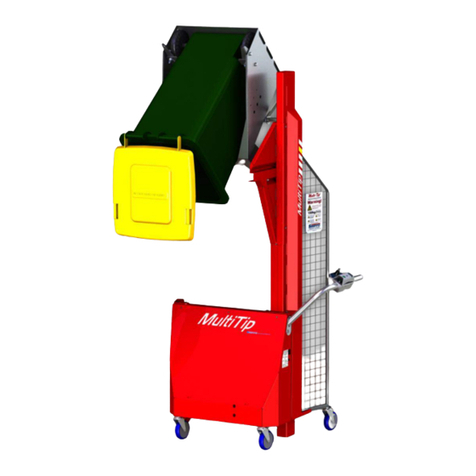
Simpro
Simpro Multi-Tip 1600 User manual
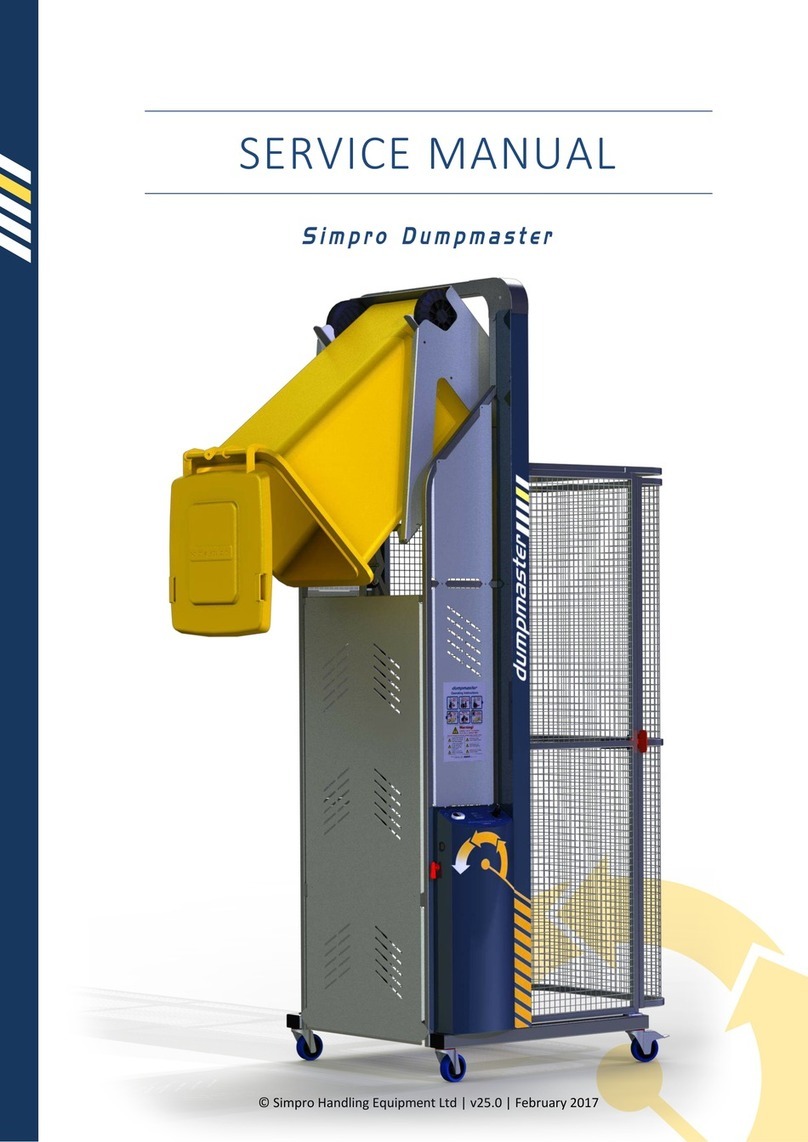
Simpro
Simpro Dumpmaster User manual
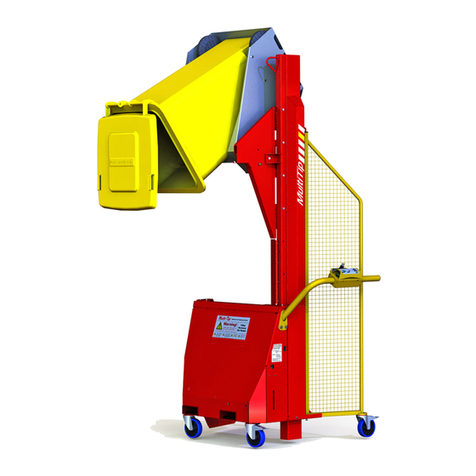
Simpro
Simpro Multi-Tip User manual
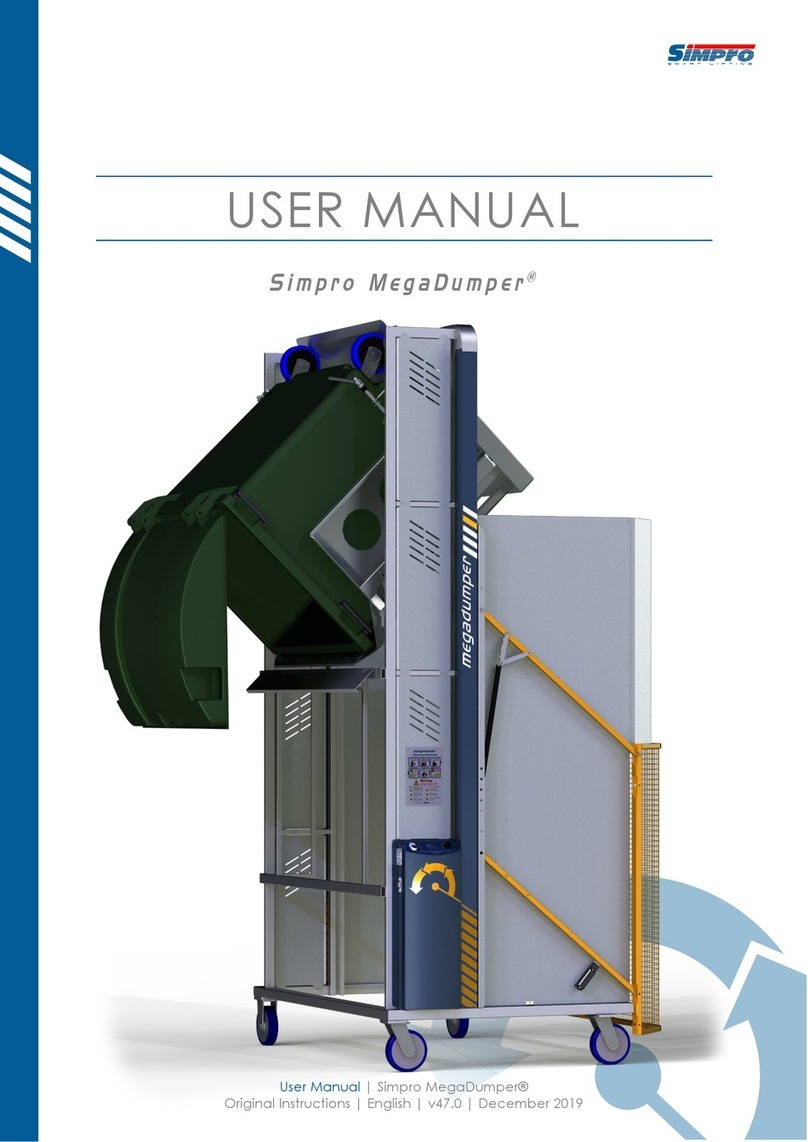
Simpro
Simpro MegaDumper Series User manual
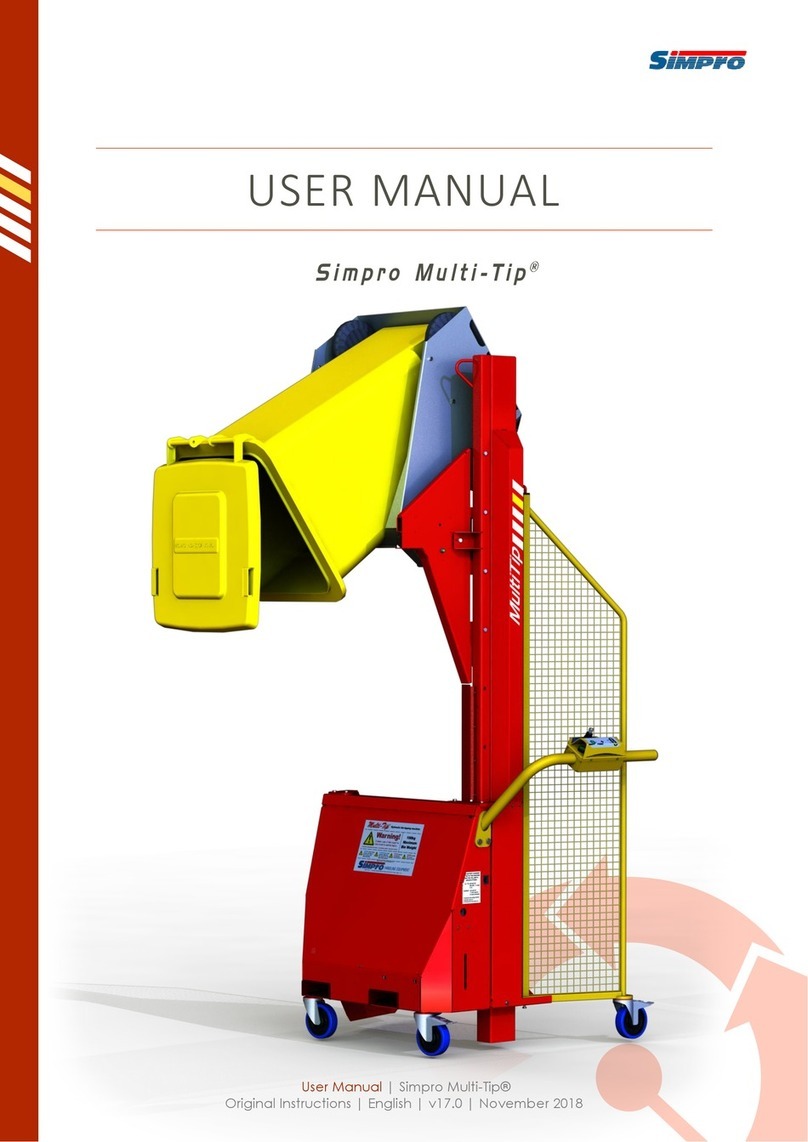
Simpro
Simpro Multi-Tip User manual
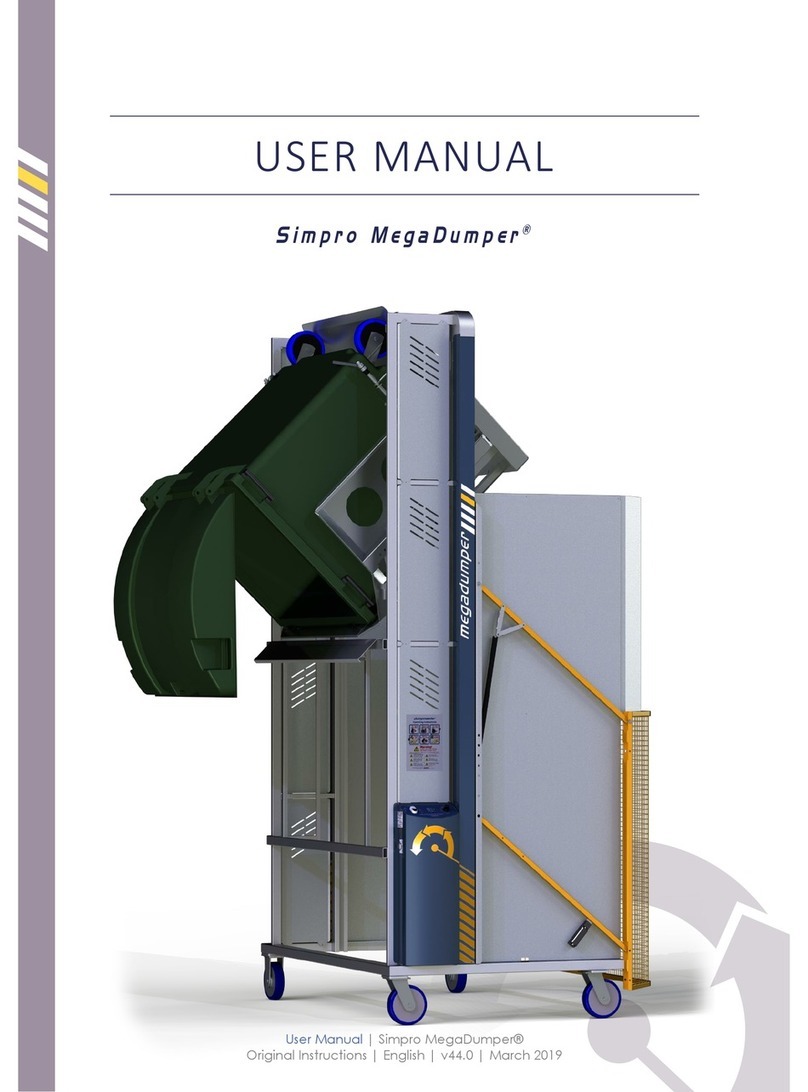
Simpro
Simpro MegaDumper User manual

Simpro
Simpro QUIKSTAK QS10MM User manual

Simpro
Simpro EUROVER User manual
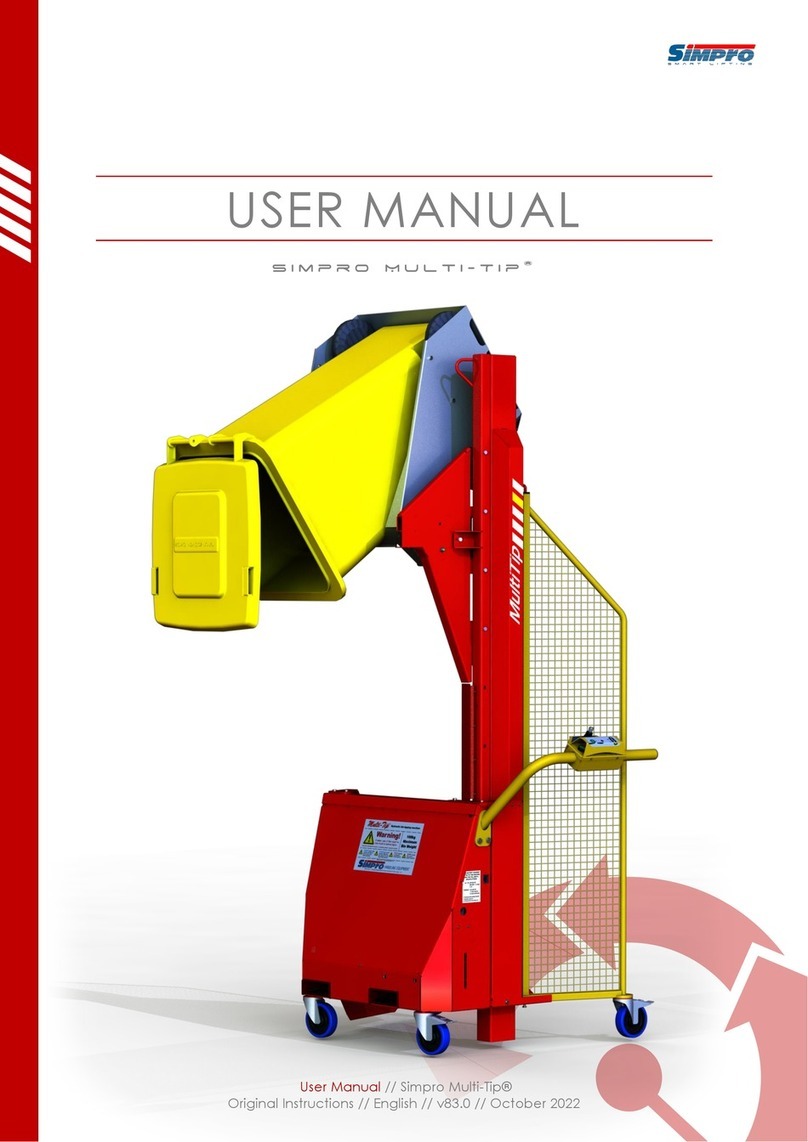
Simpro
Simpro Multi-Tip MT1200 User manual
